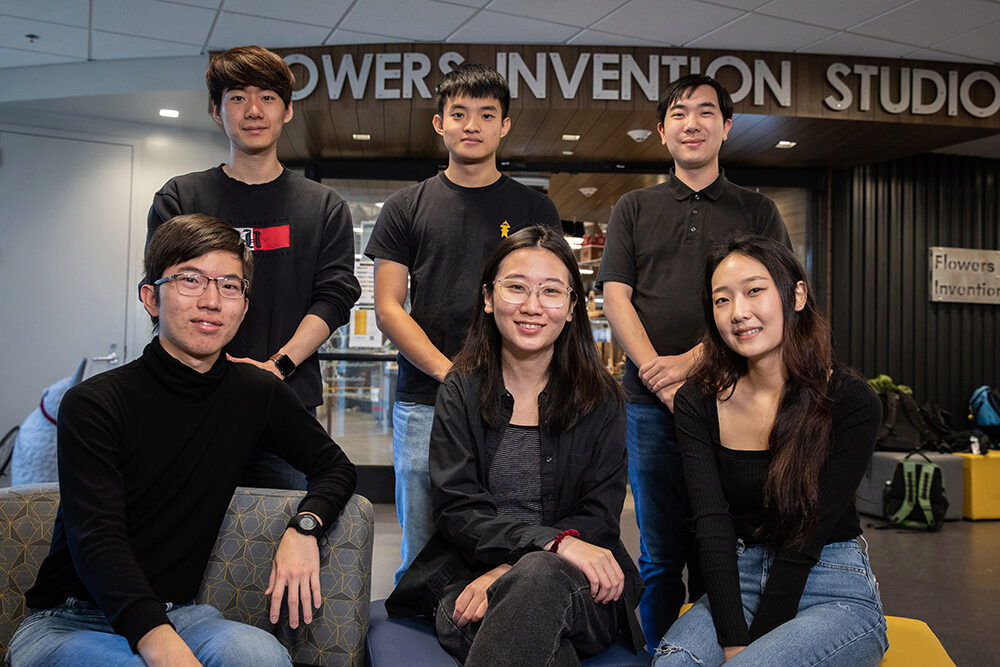
The Friday Five with Capstone Design Team Adaptable Mechanics
November 11, 2022
Get to know mechanical engineering team Adaptable Mechanics who will showcase their project, “Quiet cooling alternatives to direct water cooling of magnetically levitated nano-precise scanning,” at the fall 2022 Capstone Design Expo.
1. Can you tell us about your team and project?
Adaptable Mechanics team members include:
- Rachel Goh, mechanical engineering major from Penang, Malaysia
- Heather Heesu Jo, mechanical engineering major from Johns Creek, Georgia
- Nelson Jiang, mechanical engineering major from Commerce, Georgia
- Sze Hou Loh, mechanical engineering major from Subang Jaya, Malaysia
- Kyeonghun Min, mechanical engineering major from South Korea
- Andrew Tai, mechanical engineering major from Hong Kong
Our project titled, “Quiet cooling alternatives to direct water cooling of magnetically levitated nano-precise scanning,” is focused on identifying alternative thermal cooling solutions that have high heat dissipation capacity and low vibrational effects on photolithography machines.
The original cooling system is a traditional water flow cooling system, and we have worked on identifying and calculating theoretical solutions for multiple alternatives such as a hydrogen cooling system, a thermoelectric cooling system, and a heat pipe cooling system. Additionally, our team also optimized for the best cooling system design by tuning the parameters such as pressure flow through channels, channel width and number of channels, and also velocity flow of fluid across channels.
2. What was your team’s design process, how do you go about separating tasks, and what are some of the biggest challenges you have faced?
The team’s design process started by first identifying the key boundary conditions that limited the problem, and then identifying the required specifications for this specific problem. After that, the team worked on brainstorming and researching multiple methods of heat dissipation that would serve as a potential cooling system, and compared the various designs with a Pugh matrix to identify the best design.
As for separating tasks, each member has worked on various different alternatives, and open, effective communication was crucial for the team as a whole to work cohesively to bring all the alternatives to be compared on the same metrics.
One of the biggest challenges we’ve faced in the design process is the lack of a clear goal since our project is more of an exploration of concepts. This open-ended nature of the project has made it hard to define guidelines and approach this problem. There are so many possible solutions out there, all with their tradeoffs, and we know we must explore all of them exhaustively to find a better solution to offer to our sponsor. However, this problem is niche enough that there is no existing solution that we can take inspiration from.
3. Have there been any highlights while working on your project?
A highlight of our project has actually been learning and developing a simulation of the various alternative cooling methods in COMSOL, a Multiphysics software that allows us to visualize the distribution of surface temperatures of the reticle. One of the requirements for the project is that the surface temperature needs to be below 2 degrees Kelvin, and being able to visualize the surface distribution of temperatures for various velocities of the cooling fluid and pressures allows us to understand the optimal solution of the problem easily.
4. Can you tell us about your experience working with a sponsor?
By working with our sponsor, ASML, we have been able to practice important skills such as effective communication and project management. In doing our best to contribute meaningfully to the sponsor’s technical needs within our capabilities and available resources, we have also made sure to meet the academic requirements of the capstone design course. This requires the team to communicate effectively with our sponsor as well as our advisor, Prof. Jiao, Jianxin, regarding our project status in a concise but thorough manner.
5. What team attributes have contributed the most to your success?
Our trust in one another has been a solid foundation of our team’s success. Throughout all the challenges that we’ve faced thus far, the collaboration and support between team members have been invaluable in coming up with solutions. Furthermore, we practice open communication and ensure that each member has the opportunity to voice their opinions. This leads to effective brainstorming sessions that allow us to identify multiple alternatives and optimize our solutions to design the most effective cooling system for our project sponsor.
The fall 2022 Georgia Tech Capstone Design Expo will take place on Monday, December 5, from 4-8 p.m. at McCamish Pavilion on the Georgia Tech Campus. At the Expo, over 600 seniors from various disciplines of engineering and industrial design will showcase their innovative projects designed and built during their Senior/Capstone Design course. Register to attend.
